The Essential Guide to Tash Rabat Caravanserai
Hidden in a high mountain valley near the Chinese border is Tash Rabat, a 15th-century stone caravanserai. Tucked into the side of the hills, Tash Rabat is extremely photogenic, as is the peaceful and beautiful valley that it calls home.
Extremely isolated and sitting along the road to China, few travellers make the journey out to Tash Rabat.
There’s quite a bit here to explore, so if you’re into offbeat and off-the-beaten-track destinations, then you’ll enjoy a visit to Tash Rabat. (I mean, you’re travelling through Kyrgyzstan so you must be, right?)
Read on for our complete guide to Tash Rabat, featuring everything you need to know to visit including how to get there, where to stay and what to do once you’re there.
Kyrgyzstan Travel Resources
- Start here: 14 Awesome Things to Do in Kyrgyzstan
- Getting there: search for flights to Kyrgyzstan
- Guidebook: pick up a Bradt Kyrgyzstan guidebook
- Where to stay: search for guesthouses or yurts
- How to get around: rent a car to get around Kyrgyzstan
- Travel insurance: get travel insurance for your trip
- Money: get a Wise travel card to save big time in Kyrgyzstan
- Gear: pick up a Steripen for clean water 24/7
- Tours: check out the best Kyrgyzstan tours
What is Tash Rabat
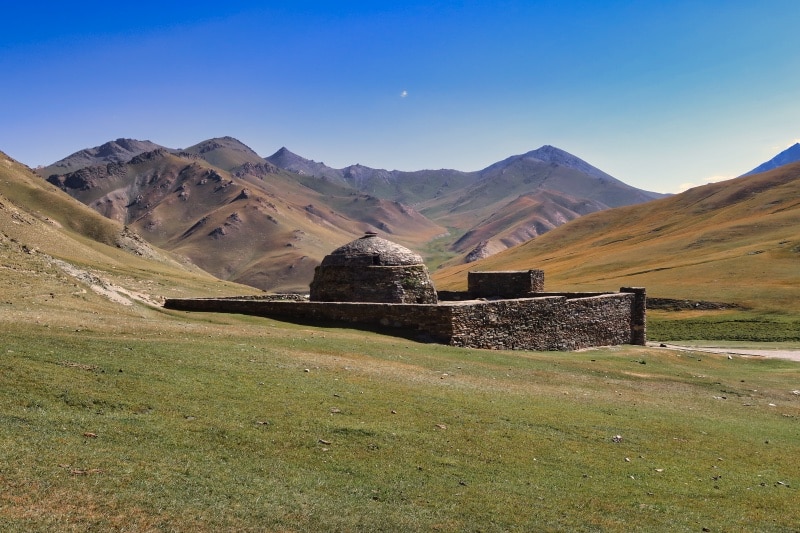
Tash Rabat is a 15th-century caravanserai located in an isolated valley, near the Chinese border, at around 3000m elevation.
What is a caravanserai, you ask? Well, caravanserais were inns along the Silk Road, places where travellers could stop for a few nights to rest themselves and their animals.
They’re cool pieces of history and considering Kyrgyzstan doesn’t have a lot of historical sites left, Tash Rabat is a pretty unique place in the country.
Read 14 Awesome Things to Do in Kyrgyzstan for more off-the-beaten-track adventures
The name ‘Tash Rabat’ is Kyrgyz for ‘stone fortress’ and that’s exactly what this little caravanserai is – a tiny stone fortress, nestled high in the mountains in the middle of Asia (and the middle of nowhere).
Adding to the intrigue is the fact that the history of the Tash Rabat caravanserai is unsettled: the common story goes that it was a 15th-century caravanserai, however, there are others who believe it was a Buddhist monastery before this. There are yet others who think it was a Christian site. Who really knows? Not me, that’s for sure!
Tash Rabat valley
The Tash Rabat caravanserai sits in a very beautiful valley that has some of its own attractions. These are Chatryr Kul Lake and Chatyr Kul Pass (also known as the Panda Pass).
Chatyr Kul Lake is Kyrgyzstan’s third largest lake, at 23 km long and 11 km wide, and is fringed by snowcapped mountains that make up the Kyrgyz border with China.
The Chatyr Kul Pass (or Panda Pass) is a high-altitude mountain pass that offers some pretty cool vistas off into China.
Both Chatyr Kul Lake and Chatyr Kul Pass can be visited from Tash Rabat – read more on this below.
Where to next? Read The Ultimate Guide to Kel Suu Lake
When to Visit Tash Rabat
Tash Rabat can theoretically be visited year-round.
That said, it is located in the mountains at a high altitude, so things get complicated in the winter. The roads become more challenging, the yurt camps won’t be operating and you won’t be able to trek into the mountains. Really, at this time of year, you can only really do a day trip.
Considering this, the best time to visit Tash Rabat is from June to September. These months fall within Kyrgyzstan’s summer, so the days will be warmer and the nights not as cold (but considering you’re at 3000m, it can still get cold).
Where is Tash Rabat
First order of business: the Tash Rabat caravanserai is located in the middle of nowhere!
More specifically, Tash Rabat is located in the At-Bashy District of Naryn Oblast in south-central Kyrgyzstan close to the Chinese border. The road to Tash Rabat goes to Torugart Pass, the actual border post between Kyrgyzstan and China.
Tash Rabat is 120 km from Naryn city, about a 2-hour drive away. Naryn is the administrative capital of Naryn Oblast in Central Kyrgyzstan and where you can base yourself to get organised for a trip to Tash Rabat.
Looking for a great hike near Bishkek? Check out Kol Tor Lake
How to Get to Tash Rabat
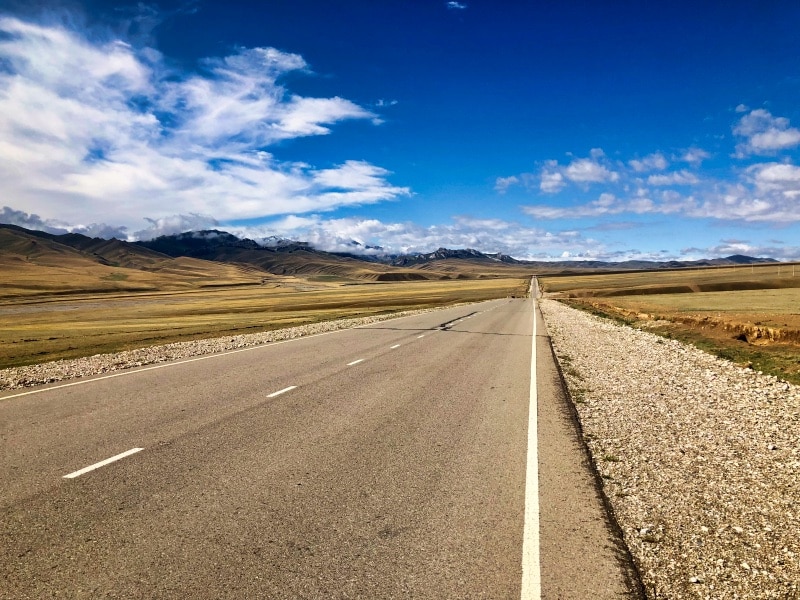
Unfortunately, because it’s literally located in the middle of nowhere, there aren’t a lot of options for getting to Tash Rabat.
There is no public transportation to Tash Rabat, so unless you have your own set of wheels or want to take a tour, the only realistic option is to hire a driver to take you there. This can be easily arranged in Naryn.
You can hire a driver through the Naryn CBT, a travel agency or privately. Through the CBT office, it should cost approximately 5000 KGS.
It’s much cheaper if you hire a driver privately – expect to pay around 3000 KGS. You can do this by asking at your guesthouse or going to the Naryn bus station and negotiating with the drivers there.
The driver will wait for you to walk around the caravanserai, but if you would like to spend the night (which we recommend), then he will want an extra 500 KGS per night to cover his expenses. If you don’t want to pay the extra amount, then hitchhiking back is your only option (read more on this below).
Important: if you plan to visit Kel Suu whilst in the area (and we suggest you do!), you can combine both destinations into one trip. This will be more efficient than returning to Naryn in-between visits.
Tours to Tash Rabat
Looking to visit Tash Rabat on a tour? Well, you can easily pick up a tour to Tash Rabat in Naryn, as many tour companies visit the site regularly.
Or, if you want to find something online, Tash Rabat can be included on a bigger 10-day Kyrgyzstan tour.
Related – Ala Archa National Park: The Ultimate 2024 Guide
Self-Driving to Tash Rabat
Of course, if you have your own set of wheels, driving yourself to Tash Rabat caravanserai is always an option. Many people rent a car in Kyrgyzstan to get around and this is indeed a great option.
If you’re looking to rent a car (sans driver) in Kyrgyzstan, head over to Discover Cars. It’s what we personally use and recommend. It’s never let us down!
From Naryn, it’s a pretty straightforward 2-hour drive to Tash Rabat, with the vast majority of the driving on the A365 highway.
Hitchhiking to Tash Rabat
Is hitchhiking to or from Tash Rabat caravanserai an option? Yes, but not a great one.
It’s very difficult to hitch a ride to Tash Rabat, as most people are going in cars they have organised from Naryn, which will usually be full.
Hitchhiking back is possible, but you need a lot of time and patience. First of all, Tash Rabat is 15 km from the main road. Once you’ve passed that hurdle, know that the main road doesn’t receive a lot of traffic.
I tried hitchhiking back and it was tough going. I was stuck on the road for a long time before I managed to coax my way into a tour bus (the guide wasn’t particularly happy about me crashing their party). However, my experience was in 2022 when the Torugart Pass border crossing with China was closed due to COVID, so hopefully things have improved since then!
If you have any updated information on hitchhiking to or from Tash Rabat caravanserai, your comments below are very welcome.
If you’re determined to hitchhike back, your best bet is to speak to other travellers or the yurt camps at Tash Rabat to see if anyone going to Naryn has space available.
If you can get to the village close to Tash Rabat, then it should cost 100 KGS from there in a shared taxi to At-Bashy. Then from At-Bashy, shared taxis leave regularly for Naryn and cost 200 KGS a seat.
Stopping by Kazakhstan? Read our complete guide to Almaty
Do You Need a Permit to Visit Tash Rabat?
If you simply want to visit the Tash Rabat caravanserai and hike to Chatyr-Kul Pass, then no, you do not need a permit.
But, if you want to go down to Chatyr-Kul Lake (which is directly on the border with China), then technically, a permit is required (see below). That said, looking at the lake, it didn’t appear that anyone was there who looked like they were checking.
Related: Ala Kul Lake Essential Guide
What to Expect at Tash Rabat
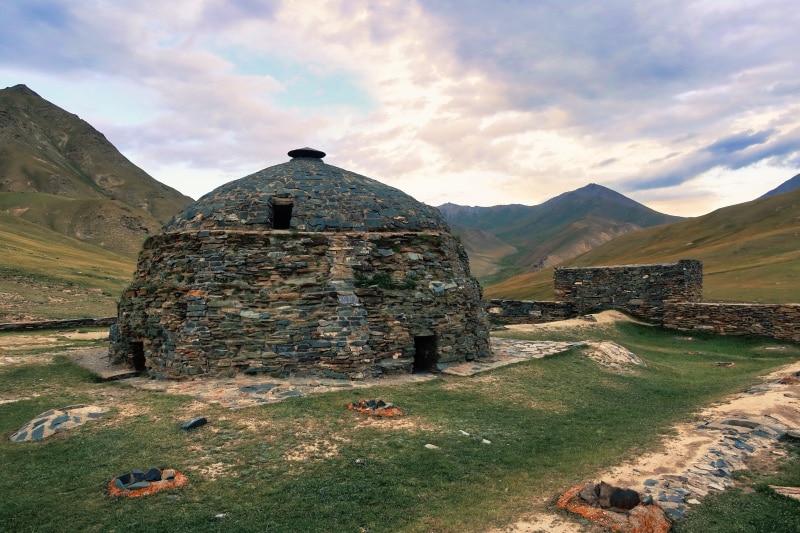
- There is no phone reception at Tash Rabat, so make sure you have downloaded any maps that you may need.
- Besides the few yurt camps in the valley, there are no facilities. Bring enough water and any other supplies you may need. We always recommend travelling with a Steripen so you have access to clean water anytime.
- Even if you’re staying in a yurt camp, visiting Tash Rabat is a wilderness experience. There are no showers at the yurt camps, so be prepared to rough it for a couple of days.
- The weather at Chatyr Kul Pass can change super rapidly, so be prepared. When I was there I experienced rain, heat and gale-force winds. Layer up!
What to Do at Tash Rabat and Panda Pass
Visit Tash Rabat Caravanserai
Obviously, the main activity at Tash Rabat is to visit the caravanserai!
The caravanserai costs 100 KGS per person. There aren’t really any official hours but a woman from the closest yurt camp will come to open it up for you. She’s very nice!
The caravanserai is made up of 31 small dome-shaped rooms, with a big main hall with small holes in the ceiling to let light inside. Honestly, it’s quite small and taking your time, you should be able to see it all in 20 minutes.
You’re also allowed to walk on the roof of Tash Rabat caravanserai, which offers a different perspective and feels a bit naughty.
Pro tip: spend the night and make an extra visit to the caravanserai around sunset. It’s really special to walk around (and on!) the building as the sun is going down, plus, during this time no one is really around. I found this quite amazing.
Hike to Chatyr Kul Pass / Panda Pass
- Distance: 24 km roundtrip
- Type: there-and-back
- Elevation gain: approx 1000m
- Time: 6 – 8 hours roundtrip
- Level: moderate
Hiking to the top of Chatyr Kul Pass (4025m) is becoming another popular activity at Tash Rabat.
It’s a nice hike and as long as you’re physically fit and okay with walking a long distance, doable in a day. It’s not the most mind-blowing hike I’ve ever done, but definitely worth doing if you’re there and physically able to.
There is an offline map of the trail available on maps.me, AllTrails and Wikiloc.
The hike is relatively moderate until the end. Then it becomes steep AF. Luckily, this is a pretty small portion of the hike. The views from the top over Chatyr Kul Lake and into China are pretty cool. From the pass, you can see Chatyr Kul Lake fringed by snowcapped mountains (which actually form the border with China).
This is probably the closest you can see into Xinjiang, China without being subject to a full body search, so take a second to enjoy the special moment.
You do not need a permit to hike to Chatyr Kul Pass (only if you plan to visit the actual lake – see below).
Hike to Chatyr Kul Lake
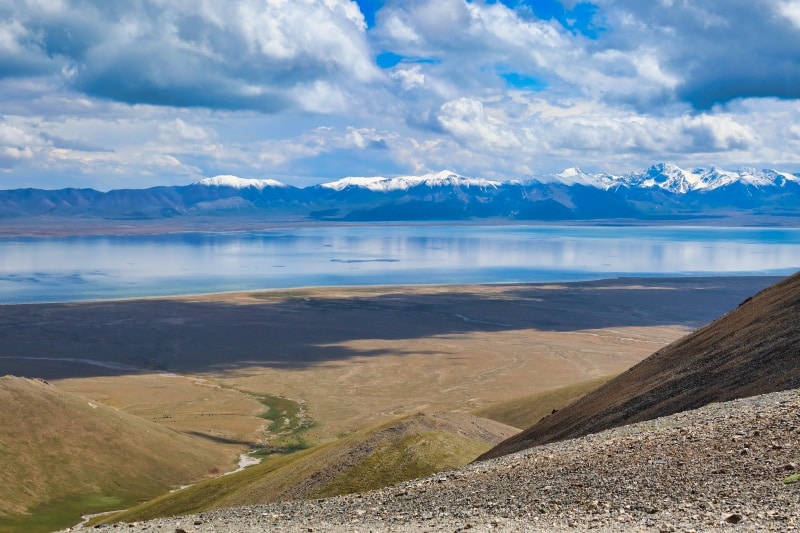
You can go to Chatyr Kul Lake (3500m) from Tash Rabat. Do note that due to distance, you will need to spend the night there and arrange a permit from the Naryn CBT office in advance.
There appears to be a yurt camp that sporadically sets up at Chatyr Kul Lake, but inquire at the Naryn CBT office if it’s currently in operation before making plans. Otherwise, you will have to camp and be completely self-sufficient.
Note that Chatyr Kul Pass is quite the hike and going to the lake is out-and-back, so if you go down to the lake you will have to climb the pass again.
The best option is to stay at the yurt camp (if it is open), so you don’t have to worry about lugging gear up, down, up and down again the Chatyr Kul Pass.
How to Get a Permit for Chatyr Kul Lake
There are two types of permits:
- Single zone permit (i.e., Naryn region only) – 1000 KGS. Choose this if you know you’ll only be travelling to Chatyr Kul Lake and/or Kel Suu Lake.
- Multi-zone permit. This permit enables you to travel to all border regions in the country – 1500 KGS. Choose this if you think you’ll be visiting any other border regions in the country.
The permits are relatively easy to acquire. The easiest, and cheapest, way to arrange a permit is to contact the Naryn CBT office at least 7 days in advance. The manager, Gulira, will ask you to send all the relevant details (i.e., what type of permit you want and when you want it to start) and a photo of your passport to her on WhatsApp and make the payment in Euros only via PayPal.
I know, it very much sounds like a scam and when I did this, I was worried that I had paid someone to steal my identity. But this is Central Asia, and things work differently, and this is in fact how it is done.
It’s worth noting that even if you do the above steps 7 days in advance, it’s likely your permit won’t be ready on the day you arrive in Naryn. Despite ordering mine 2 weeks in advance, I still had to wait a day for ‘extra processing’. Just keep this in mind when budgeting your time.
It’s also worth noting that although the Naryn CBT website says that pick-up for multi-zone permits is in Bishkek, you can pick it up in Naryn (that’s what I did).
If you haven’t arranged a permit in advance and still want to visit Chatyr Kul Lake, then you can pay extra for urgent processing. This costs 2,000 KGS for a single zone permit and 3,000 KGS and these can be arranged in 2 business days.
Horse Riding at Tash Rabat
This is Kyrgyzstan, so of course, horse riding at Tash Rabat is an option. Any of the yurt camps will hire horses and guides. Riding up to Chatyr Kul Pass is the most popular option.
You can also horse trek to Chatyr Kul Lake, but because of the required permit, this must be organised in advance in Naryn.
Want more horse trekking in Kyrgyzstan? Be sure to visit Song Kul Lake
How much time should I spend at Tash Rabat?
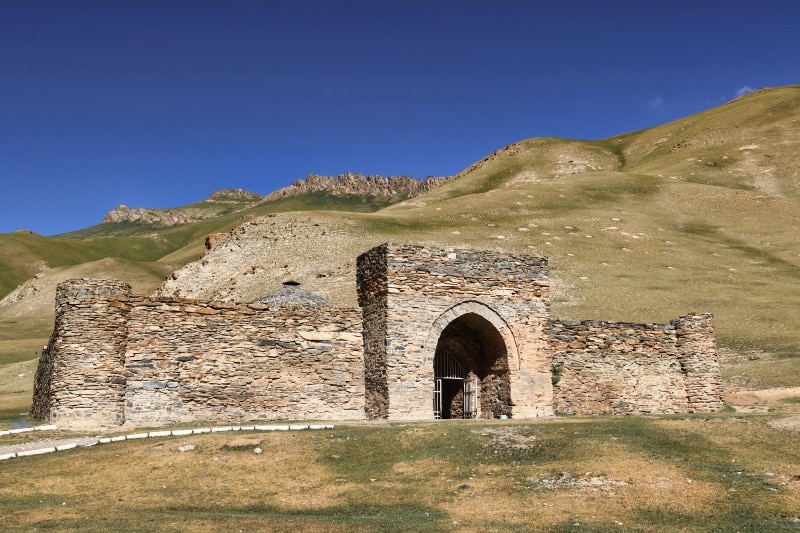
Ideally, you should spend at least 1 night at Tash Rabat. This way, you have time to explore the caravanserai and hike to Chatyr Kul Pass.
We recommend either:
- Arrive early and start the hike to Chatyr Kul Pass immediately when you get there, visit the Tash Rabat caravanserai in the late afternoon, spend the night and leave the next day; OR
- Arrive late, visit the caravanserai, get up early, do the hike and leave.
If you want to visit Chatyr Kul Lake, then you will need to budget an extra night.
Of course, you can always stay longer. I stayed for two nights, just enjoying the peaceful vibes of the valley and exploring the hills.
Is Tash Rabat worth visiting?

People have mixed feelings about Tash Rabat. Some people love it, while others are disappointed.
Honestly, if you’re making the trip just to see the caravanserai, unless you’re a really big history buff, then yes, you might be disappointed.
Driving 2 hours completely out of the way to spend 20 minutes examining an old stone structure might feel underwhelming.
But if you spend at least a night there, take in the scenery and explore the area, in addition to visiting the caravanserai, then it’s a great experience and definitely worth a visit.
Our view? Tash Rabat needs to be viewed in its totality, as it offers a lot more than just the little stone fortress.
Where to Stay at Tash Rabat
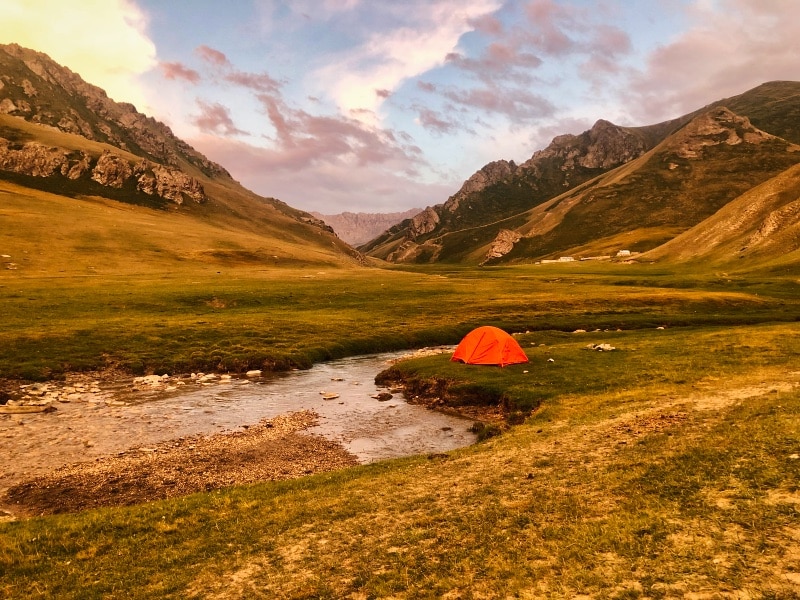
There are a number of yurt camps at Tash Rabat, all offering breakfast and dinner. You don’t need to worry about booking in advance. Some even have saunas that you can rent for an hour!
If you’re into camping, there are plenty of spaces for wild camping at Tash Rabat – just stroll up or down the valley to find your spot.
You can set yourself up in a more isolated spot, or closer to one of the yurt camps. Just be sure to speak to the people running the yurt camp to get the okay from them!
I set myself up on a very lovely, flat pitch near a stream just past the final yurt camp, where I had access to flowing water (I still treated it) and negotiated with the owners of a nearby yurt camp to use their toilet (there’s not a lot of private spaces if you know what I mean).
Where to Stay in Naryn
You’ll most likely be spending at least a night in Naryn on either side of your trip to Tash Rabat.
Unfortunately, great-value accommodation options are not abundant in Naryn.
Budget
Kubat Tour Hostel
Kubat Tour Hostel is probably one of the cheapest places in town and for the price, is decent enough. The host is very friendly and speaks good English. The private rooms are tiny but comfortable.
Mid-range
Top-end
Like this post? Pin it for later!

Disclaimer: This post contains affiliate links. This means that if you buy or book anything through them, we’ll earn a small commission at no extra cost to you. This helps us run this website and create comprehensive guides to help you get off the beaten track. We only recommend products and/or services that we use ourselves and trust.


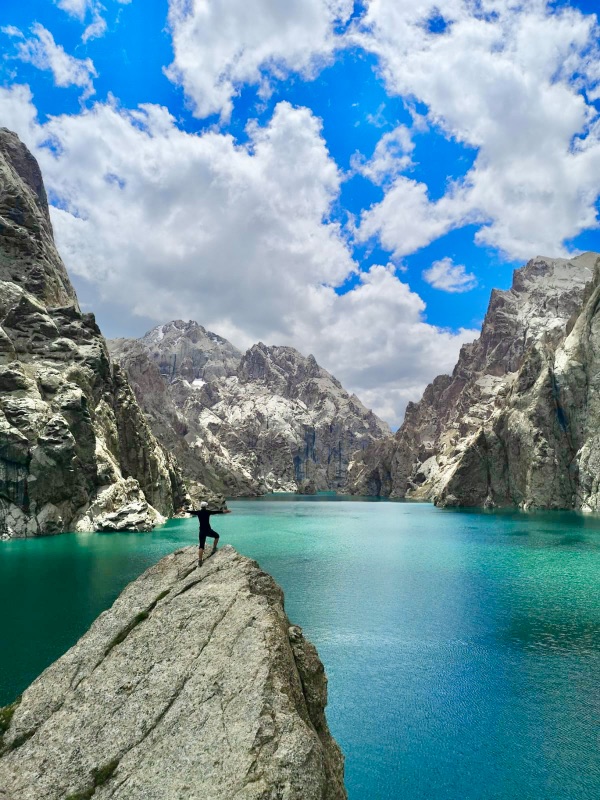



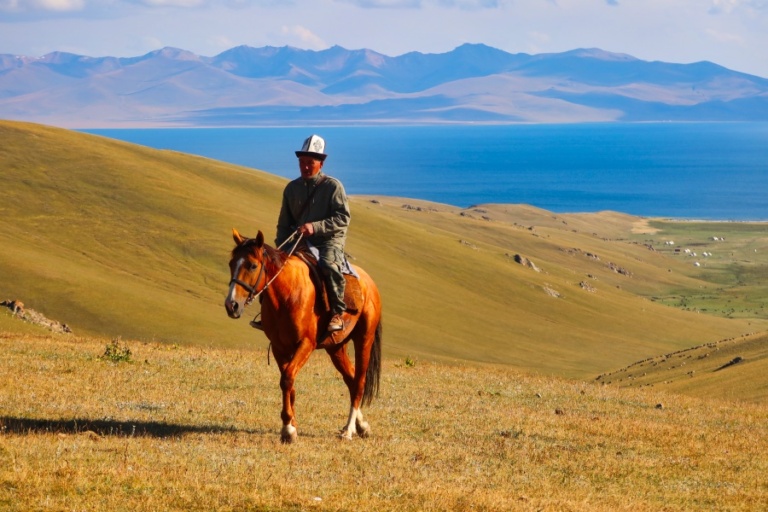

I would absolutely spend the night and make an extra visit to the caravanserai around sunset. What a memory!